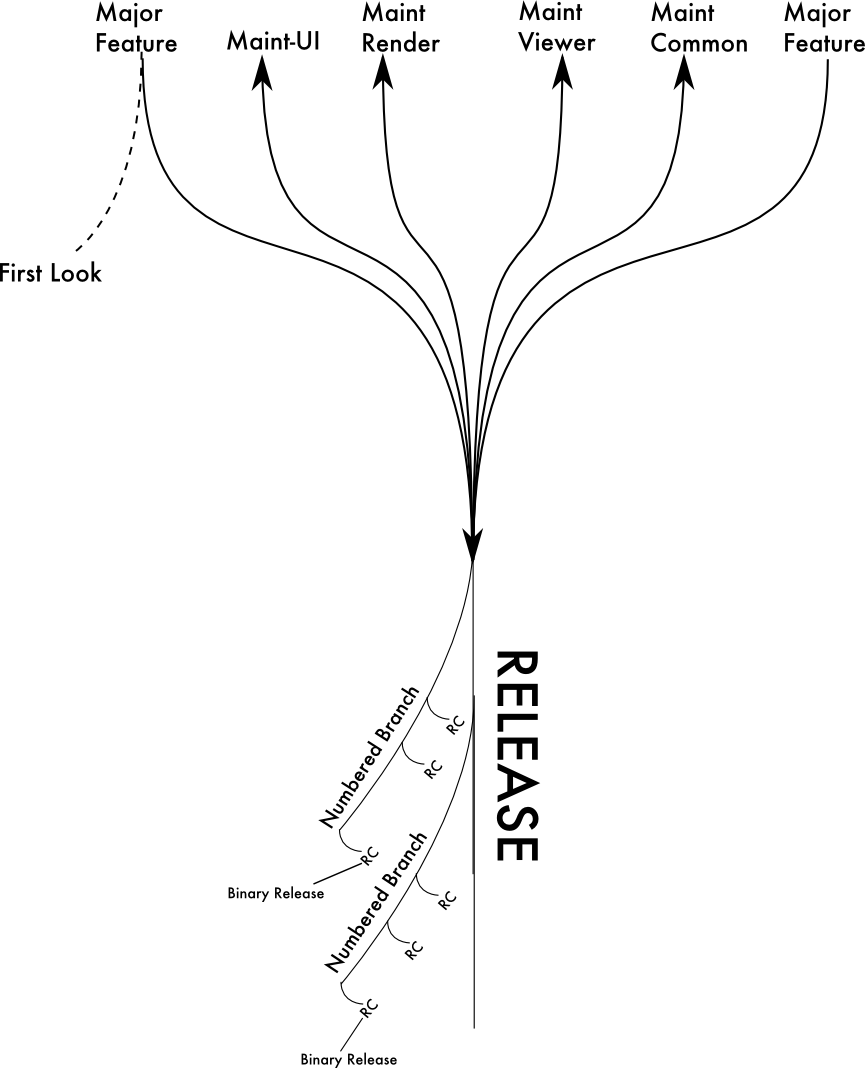Source branches
The public version control repository provided by Linden Lab has many of the same branches that Linden Lab's internal repository has.
http://svn.secondlife.com/trac/linden/browser/branches
There are several major branches at all times, along with many temporary development branches:
- "maintenance" - bug fixes and small features that don't warrant their own branch get checked into maintenance. There are actually several maintenance branches internally, UI/Server/Viewer/Rendering. Changes from maintenance are periodically merged up to release after QA has tested a build from the branch. Many source code contributions from the community land in this branch first.
- feature branch a major new feature gets developed here before turning into various first looks (snapshots of this branch), or getting eventually merged into "release" and no longer maintained as a feature branch.
- "release" - the main trunk of development. This is often referred to as "head" or "trunk" in other organizations. Linden Lab is rather conservative about what gets checked into release, though, preferring that development work mainly happens on branches (either a dedicated feature branch, or one of the "maintenance" branches for the small stuff, and only gets merged into release once QA has happened). Developers aspire to keep "release" compatible with the agni (main) grid. All branches occasionally pick up changes from release, and are occasionally merged back into release.
- Numbered branch (currently "Branch_1-18-3-Viewer") - this is a branch of release that is where RC snapshots come from, and where final releases are checked in. Small fixes can be checked in here if they fix regressions.
Linden Lab does feature development on temporary branches. As those features are validated by the QA group, they are merged into the "release" branch. Three kinds of releases are possible:
- Server-only - may occur with or without downtime
- Viewer-only - optional viewers
- Viewer and Server (with dependencies) - required viewer updates. This case is avoided whenever possible.
Release Candidates
When a release is about to happen, a release candidate (RC) branch is created for work on that release (e.g. "Branch_1-13-2"). In the rare case of a client/server update with dependencies, pending changes which would break compatibility with the main grid and require downtime and new viewers for an update are merged into this release candidate branch.
Following this point, only stability work is done on the branch - developers fix any new bugs above a certain priority that are found by QA.
For server-side changes, the beta grid is updated frequently as the stabilization occurs. Once the code is finalized, it is deployed to the main grid. After that, any stability work in the RC branch gets merged back into "release", and the process repeats for the next major release. Additional patches may be made to the RC branch and deployed to the grid.
For viewer-side changes, once the code is deemed stable it is released as Release Candidate viewer. Any bug reports which are new to this version are triaged. As fixes are made, additional RC viewer builds may be made and released. Once no more bugs have passed triage, the final RC becomes the next released viewer.
Maintenance
"Maintenance" is now subdivided into four branches in order to distribute and organize maintenance responsibilities between development teams. (new as of August 2007)
Maintenance Branches
- maint-ui
- UI specific maintenance tasks
- maint-render
- Render specific maintenance tasks
- maint-viewer
- Other viewer only maintenance tasks
- e.g. viewer crashes, audio, misc
- maintenance
- Tasks that involve server-side changes
- Tasks that affect shared viewer / server libraries
- Tasks that in any way affect messaging
